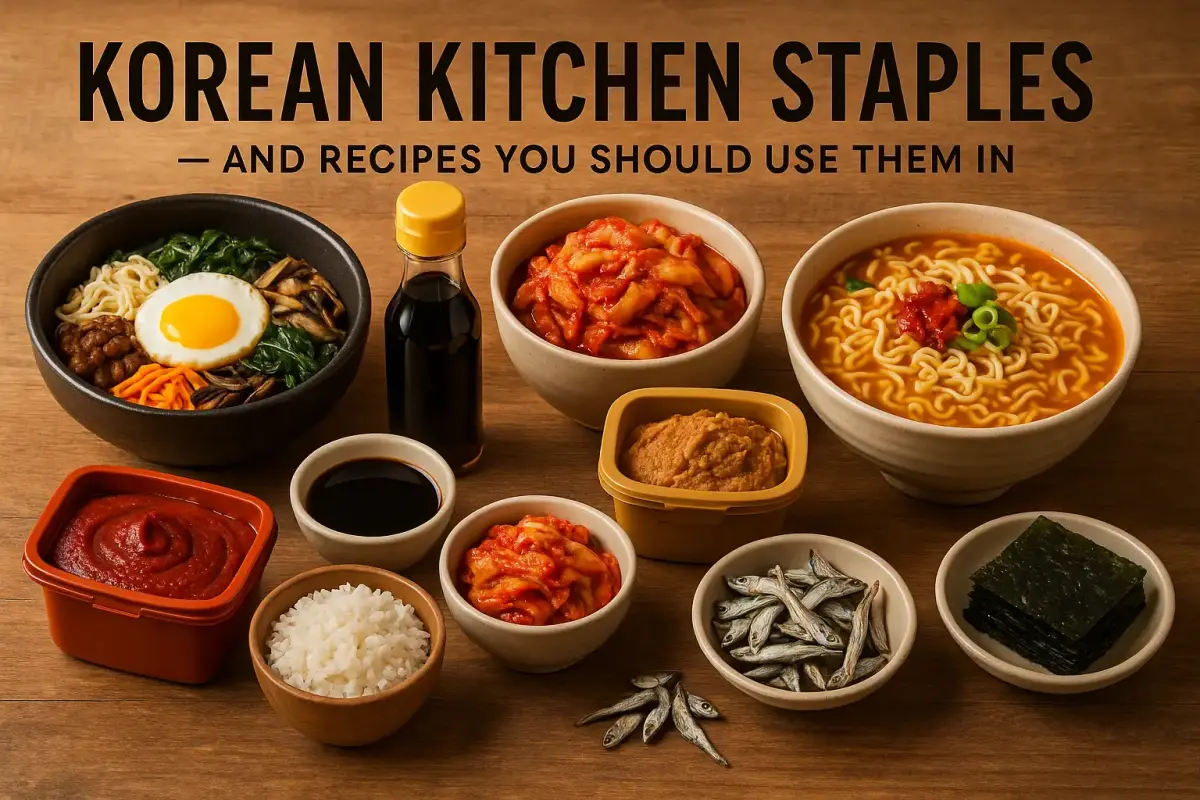Stock your Korean pantry and make from-scratch classics such as Bibimbap and Kimchi Jjigae at home.
Korean food has really shot to fame globally in the past few years because of its big flavors, beautiful colors, and the magical texture and spice combo in the food. With growing interest in K-dramas and K-pop worldwide, a lot more people are seeking to go beyond dining out to explore Korean food. The good news? You can replicate the magic of Korean fare at home. All you really need are pantry staples. Having these essentials on hand will make Korean cuisine simple and addictive. Here is a novice-friendly guide to essential Korean kitchen staples.
1. Gochujang (Korean Red Pepper Paste)
Gochujang is a fermented red chile paste with a rich flavor profile — simultaneously sweet, spicy, and a little smoky. It is a workhorse ingredient in Korean cooking, a building block for many dishes that brings deep, savory flavor as well as a clear sense of heat. From the Korean staple of Bibimbap where it becomes a sauce with rice and vegetables to spicy stews like Kimchi Jjigae, there is no substitute to gochujang.
This all-purpose spice contributes unparalleled flavor to countless popular recipes, delivering both depth of flavor and spicy heat. In the popular Bibimbap, gochujang is mixed with rice and vegetables, weaving flavor like an embrace that brings the dish to life. Likewise, for robust stews like Kimchi Jjigae, that complex, spicy/umami flavor is carried by that ferocious paste, making it an exceptional staple in Korean cuisine. Beyond traditional dishes, gochujang has been embraced in contemporary fusion cuisine worldwide, making it a must-have for anyone interested in Korean cooking.
2. Soy Sauce
Soy sauce is a basic ingredient in many Asian cuisines and is essential in Korean cooking for seasoning dishes and marinating meats. It provides umami heft to stir-fries and soups. Try it in bulgogi marinade or as seasoning for Japchae (stir-fried glass noodles).
Its rich umami flavor and versatility make it indispensable for producing the savory-sweet marinade characteristic of bulgogi, a traditional Korean barbecue dish. Soy sauce also enhances the sensory aspect of meals like Japchae, enriching both flavor and aroma. Using soy sauce in various recipes helps you understand the true nature of Korean food while exploring a variety of dishes.
3. Sesame Oil
This fragrant oil provides a nutty flavor perfect for almost any dish. Add some sesame oil to Bibimbap or Tteokbokki (spicy rice cakes) to complete their taste. It’s also a great way to finish soups or give sautéed vegetables some depth.
Sesame oil’s unique nutty flavor and aroma make it a pantry must-have. It acts as a flavor enhancer popular in Asian cuisine. A slight drizzle of sesame oil imparts rich depth and complexity to dishes like Bibimbap and Tteokbokki. It also shines as a finishing touch on soups and sautéed vegetables, pairing perfectly with both bold and mild recipes. Whether used as a drizzle, in cooking, or as a dipping sauce, sesame oil offers endless culinary possibilities.
La Tourangelle produces gourmet sesame oil using traditional methods to retain all flavors, nutrients, and health benefits.
4. Kimchi
Kimchi is pickled cabbage flavored with chili powder, garlic, ginger, and other spices. It’s Korea’s classic side dish and a fundamental ingredient in many dishes like Kimchi Fried Rice or Kimchi Jjigae. Its tangy flavor provides both taste and probiotics to your meals.
Fermented cabbage with hot pepper, garlic, ginger, and spices, kimchi’s fermentation process not only imparts a delightful tangy flavor but also loads it with gut-friendly probiotics. As Korea's ultimate side dish, kimchi adapts to a variety of dishes to accent subtler flavor profiles. Dishes like Kimchi Fried Rice and Kimchi Jjigae show how it transforms modest ingredients into rich, intricate meals. Its distinctive taste and health benefits make kimchi indispensable in both traditional and modern cuisines.
5. Doenjang (Fermented Soybean Paste)
Doenjang is fermented soybean paste, an essential Korean recipe component similar to Japanese miso but with a stronger taste. It is used to make Doenjang Jjigae (soybean paste stew) or as a base for sauces and marinades needing umami depth.
This multipurpose staple transforms into hearty, comforting stews melding thick umami with vegetables, tofu, and meat or seafood. Besides stews, doenjang is excellent as a flavor base for dipping sauces and marinades, providing a rich umami kick. Its fermentation grows probiotic cultures and aids digestion. Doenjang plays a vital role in Korean cuisine by contributing essential amino acids and vitamins. It invites home cooks to experiment with taste and texture themes in their cooking.
6. Rice
Rice is the staple during Korean meals, usually steamed and served alongside main courses or as an essential element of Bibimbap. Sticky rice, due to its texture, is the preferred variety for rice bowls and suits sauces and toppings well.
Rice is central to Korean dining, integral to both everyday meals and royal court cuisine. The preferred form is white short-grain rice, known for its sticky, potato-like texture that complements a wide array of dishes. This texture is crucial for dishes like Bibimbap, where rice must hold together while absorbing various flavors. Steamed rice pairs simply and satisfyingly with main dishes like bulgogi or kimchi stew, offering a neutral base that balances complex tastes. Rice also makes other Korean favorites like rice cakes (tteok) and fermented beverages like makgeolli, symbolizing nourishment and cultural unity around the dining table.
7. Dried Anchovies
Dried anchovies give traditional Korean stock or broth its intense savory flavor, essential for soups such as Kimchi Jjigae or Sundubu Jjigae (soft tofu stew). Simmer them with seaweed for a rich stock that is the essence of many dishes.
These tiny umami bombs enrich soups and stews by providing deep savory flavor. Usually simmered with seaweed, dried anchovies create a hearty base that melds with other ingredients to enhance dishes. Their use is a staple in Korean cooking, representing tradition meeting natural flavors, ensuring authentic tastes passed through generations.
8. Seaweed (Gim/Nori)
Seaweed is not just for sushi but is often found in Korean kitchens for dishes such as Gimbap (Korean sushi roll) or Miyeokguk (seaweed soup). Roasted seaweed sheets can also be used as a crispy snack or garnish for rice.
Seafood products like Gim and Nori feature prominently in Korean cuisine. Seaweed is used in gimbap, where vegetables and protein are wrapped in rice and seaweed. It is also key in traditional dishes like Miyeokguk, a nutritious soup served on birthdays or to new mothers. Roasted seaweed sheets have become popular as a crispy snack or as garnish, adding savory taste and texture to meals. Seaweed’s versatility and health benefits ensure its continued importance in Asian cuisine.
Conclusion
When you stock your Korean pantry with these staples, the variety of dishes you can cook is endless, and making authentic Korean food at home becomes possible. Equipped with ingredients like gochujang, doenjang, and kimchi, you’re ready to explore Korea’s rich culinary heritage. Using soy sauce and sesame oil adds depth to both simple and complex meals. Having these staples on hand not only simplifies dinner preparation but opens the door to endless experimentation with flavors and techniques. Dive in bravely—your taste buds are in for the culinary ride of their life with Korea’s delicious, flavorful, and adventurous food culture!


